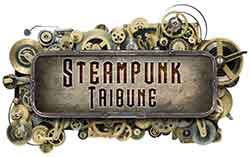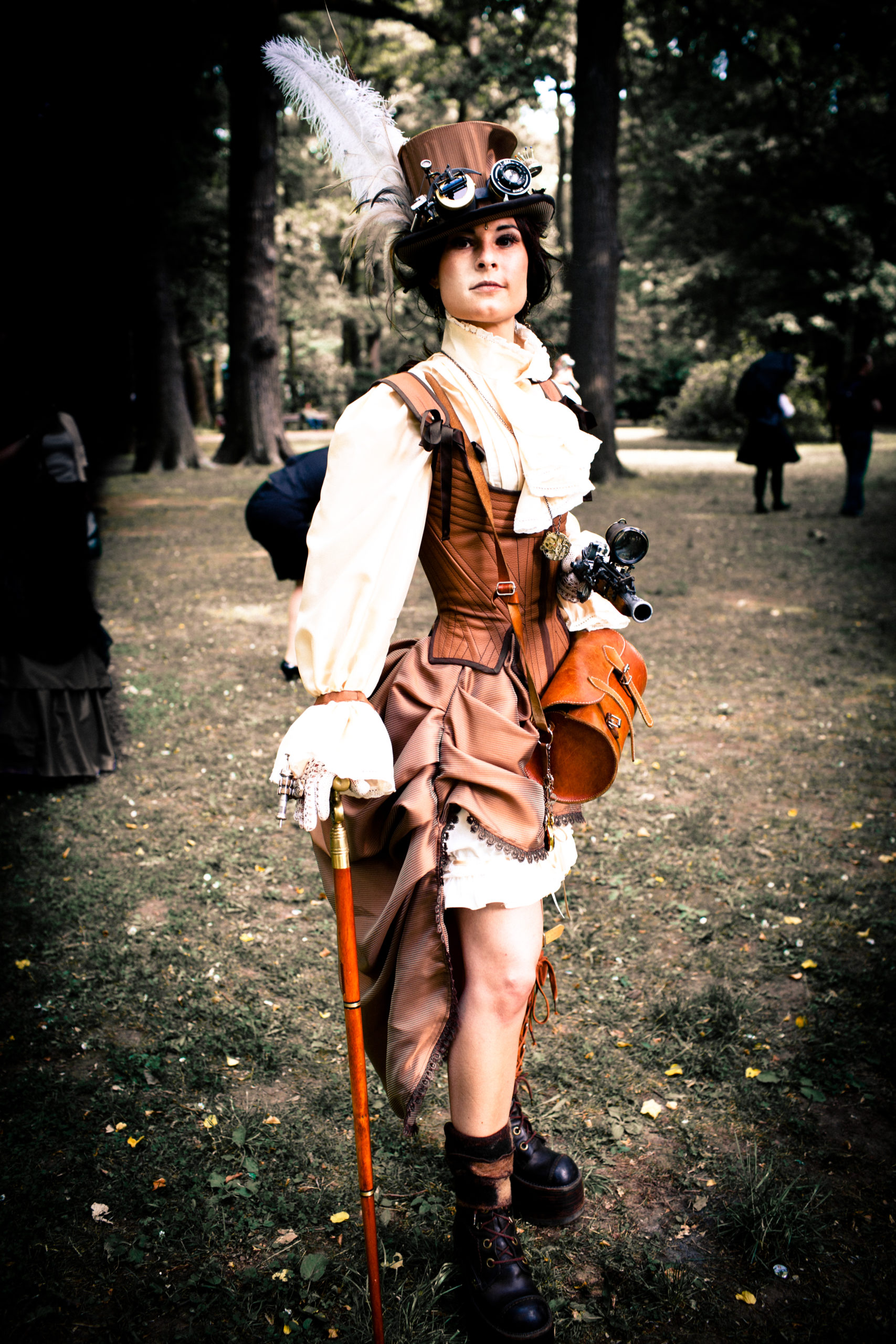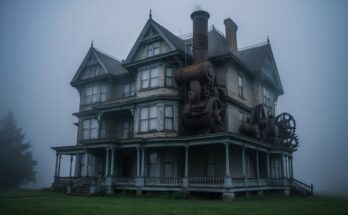All Rights ReservedView Non-AMP Version
Categories: ArticlesWhat is Steampunk?
Steampunk vision of a city
Steampunk is a subgenre of science fiction inspired by the steam-powered machinery of the late 19th century. These works are most often set in Victorian England or the American Wild West, when steam technology reached its peak.
Steampunk stories usually include alternative futures in which steam power has remained in common use, and fantasy worlds that use steam power.
The Wild Wild West is a well known steampunk movie
However, steampunk is more than a literary genre. It is art combined with science and imagination. There is steampunk art, fashion, music, and some even consider it a way of life.
Image: Stephanie on Flickr
Steampunk is distinguished from neo-Victorian literature in that technology is an essential feature of steampunk, which isn’t the case with the neo-Victorian movement.
Steampunk is a hybrid genre because it incorporates elements of many other genres, including fantasy, horror and speculative fiction, especially alternate futures.
Steampunk’s Alternate Future
Art by TerryLH
Steampunk imagines a world in the 1800s where science and technology had progressed a much more rapid pace. Victorian style gets a technology upgrade and mechanical steam-powered machines power giant airships and futuristic technology.
Where Does the “Punk” Come From?
Since the popularity of Steampunk exploded with hit steampunk movies like Wild Wild West, the “punk” in steampunk seemed to have lost some of its original meaning.
The, “punk” has been seen as coming from the gritty edge and dystopian future in some steampunk works.
However, as we see it the, “punk” in steampunk represents rebelling against societal norms. Daring to take a stand against how everyone else does things, and using creativity to represent this.
The Origin of the Term “Steampunk”
Science fiction author K. W. Jeter coined the term “steampunk” in 1987 to describe stories set in the 19th century that were inspired by the speculative fiction of that era, especially those by H.G. Wells. The first works to be specifically described as steampunk include two of Jeter’s own novels, Morlock Night and Infernal Devices.
Photo: L.W. Curry Inc
Jeter also quickly labeled The Anubis Gates by Tim Powers and Homunculus by James Blaylock as steampunk novels.
While these novels are the first to which the term “steampunk” would be applied, they aren’t characteristic of the genre since they don’t feature the development of steam-based technology or alternative histories.
Despite the origin of the term “steampunk” in the late 1980s, many works now considered central to the genre were published during the 1960s and 1970s. Literary scholars have also applied the term to works created as early as the 1950s.
Overview
Steampunk fiction prominently features modern technologies and inventions as people from the 19th century would have imagined them. Similarly, works from this genre are firmly rooted in the Victorian era’s culture, art and fashion.
Machines similar to the ones that H.G. Wells and Jules Verne describe in their stories often serve as major plot devices, especially in the works of modern authors such as Stephen Hunt, China Mieville, Philip Pullman and Scott Westerfeld.
Steampunk technology includes steam cannons and zeppelins as well as mechanical computers inspired by Charles Babbage’s Difference Engine.
Culture, fashions and styles that are based on the aesthetics of steampunk fiction are also known as “steampunk.” These include films and art nouveau designs that were typically created during the mid-20th century.
Individual artists have modified various modern objects into a steampunk style, and many musicians are also considered to be steampunk.
Early History of Steampunk
Steampunk is strongly influenced by 19th-century speculative fiction by authors such as H. G. Wells, Mary Shelley, Edward S. Ellis and Jules Verne, but literary scholars don’t consider the works of these authors to be steampunk since they were actually written during the late 19th century.
Scholars typically regard the 1959 novel Titus Alone by Mervyn Peake to be the first true steampunk novel. The 1971 novel The Warlord of the Air by Michael Moorcock is another strong candidate, although it’s clearly influenced by Titus Alone.
Moorcock’s theme of shifting between timestreams is seen in the early 1970s comic The Adventures of Luther Arkwright, generally considered to be the first steampunk comic. The Adventures of Professor Thintwhistle and His Incredible Aether Flyer published in 1980 was another early steampunk comic. The 1985 film Brazil is one of the strongest cinematic influences in the steampunk genre.
Other early examples of steampunk fiction include Worlds of the Imperium (1962) by Keith Laumer and Queen Victoria’s Bomb (1967) by Ronald W. Clark. Both of these novels apply a modern perspective to the technologies and societies of an earlier age. A Transatlantic Tunnel, Hurrah! (1973) by Harry Harrison is another early steampunk novel due to the prominent role of speculative technology, including flying boats powered by coal and atomic locomotives. The use of Victorian dialogue in this novel is also a classic feature of steampunk literature.
Culture
The popularity of steampunk is also resulting in a growing number of fans who wish to adopt the steampunk culture through art, fashion and lifestyle. Many blogs, magazines and online shops are dedicated to this culture, which combines modern technologies with Victorian aesthetics.
The Comikaze Expo founded by Marvel comic writer Stan Lee hosted a panel to discuss steampunk culture in 2012. It was chaired by entertainer Veronique Chevalier, with panelists that included members of the performance group League of STEAM and magician Pop Hadyn.
The theme of the discussion was the development of steampunk into a superculture due to its growing number of fans and incorporation of elements from many subcultures such as cyberpunk, goth and neo-Victorianism.
The online craft network Etsy began classifying some of its products as steampunk in 2009, although many of them failed to achieve the established aesthetics of steampunk.
Comedian April Winchell described some of the more notable examples of these items in her book Regretsy: Where DIY meets WTF. Winchell’s blog was extremely popular among steampunk fans until it closed down in 2013.
Steampunk Art
Steampunk art often takes its inspiration from early films of the genre. The submarine Nautilus in the 1954 adventure film 20,000 Leagues Under the Sea from Walt Disney features classic steampunk aesthetics, as do the costumes and other equipment used by the characters.
The time machine in the 1960 film of the same name is also a common source of inspiration for modern steampunk art. The steampunk airship is also a common feature of steampunk art.
Artistic designs with a steampunk theme attempt to reach a balance between form and function, although actual 19th-century reformers like William Morris and John Ruskin rejected machines entirely.
These designs are found in several of today’s theme parks like The Six Flags Magic Mountain theme park in Santa Clarita, California, which has a “Screampunk District.” The Mysterious Island section of the Tokyo DisneySea theme park near Tokyo, Japan also has a steampunk theme.
Fashion
Steampunk-themed fashion is still in its early development, but it’s generally based on modern styles with Victorian influences. These influences can be seen in women’s fashion with gowns and undergarments such as bustles, corsets and petticoats.
steampunk dress by HaoLin
Men’s steampunk fashion typically includes waistcoats, tailcoats and spats, along with top hats and bowler hats. Military-inspired garments are also a common theme in men’s steampunk fashion.
Accessories in steampunk fashion often include driving and flying goggles, timepieces, parasols, and hats.
Steampunk Hat by Storm Buy
They also include modern paraphernalia such as smartphones, although they need to be modified to have a Victorian appearance. Steampunk fashion sometimes has a post-apocalyptic look, with accessories like gas masks.
Modern Literature
Scholars often credit The Difference Engine, written in 1990 by William Gibson and Bruce Sterling, with bringing steampunk to mainstream public awareness. This novel is set in an alternate timeline where Charles Babbage’s difference engine was actually built during the Victorian era.
This steam-powered mechanical computer leads to an information revolution that occurs more than century earlier than it did in the real history. However, The Difference Engine deviates from most steampunk novels in that it takes a dystopian view of the future.
Another recent literary work that has promoted awareness of the steampunk genre is Extraordinary Engines, an original anthology by Nick Gevers published in 2008.
It features steampunk stories by established writers as well as those by new authors experimenting with the genre. The anthology entitled Steampunk was also published in 2008, which includes stories James Blaylock, Jay Lake, Michael Moorcock and Jess Nevins.
Blaylock’s Narbondo trilogy is classic steampunk, as are the contributions of Moorcock and Nevins. Lake’s Mainspring is sometimes classified as a subgenre of steampunk known as “clockpunk.”
Some steampunk authors are specifically targeting younger readers. The central theme in Philip Reeve’s Mortal Engines quartet is about moving cities fighting each other for resources, which Reeve describes as “municipal Darwinism.”
Scott Westerfeld’s Leviathan trilogy is an alternate history of the First World War in which the Allied Powers use genetically engineered life forms and the Central Powers use steam technology.
Steamteam
NextSteampunk Movies » Previous « The Tales of Sage and Savant – Podcast and NovelizationView Comments
- Breezy Carver says:July 20, 2017 at 7:04 pm
You always have had the coolest photos vidios and examples of steampunk!!
- SteamTeam says:July 24, 2017 at 9:43 am
Thanks so much!
Leave a Comment Share Published by Steamteam 2 years ago
- The Tales of Sage and Savant – Podcast and Novelization
- “Discover Steampunk” – New traveling exhibit
- Victorian lamps and the history of night light
Related Post
Recent Posts
- Apparel
The Best Most Authentic Steampunk Watches
Simply having the gears exposed doesn’t make a watch a steampunk watch! That is just a skeleton watch, which is not…
5 months ago
- Art
The Steampunk Airship Guide & 2020 Awards
The Steampunk Airship, also known as a Steampunk Ship has captured the imagination of steampunk artists and fans alike. This…
- Apparel
The Best Steampunk Pocket Watches of 2020
We’ve reviewed the best steampunk pocket watches of 2020 and created this best of list. Each watch has been selected…
1 year ago
- Apparel
What is Steampunk Fashion? A Complete Guide
Quick Links: What is Steampunk Fashion? Types of Steampunk Fashion Steampunk Fashion Accessories Best Steampunk Fashion Online What is Steampunk…
2 years ago
- Victorian Era
Victorian Last Names (Surnames)
Whether you are looking for a Victorian-sounding last name for a fantasy novel, game character or for something else entirely,…
2 years ago
- Art
The Best Steampunk Art of 2019
Steampunk art brings to life the technology and personalities of the steampunk world. This art often uses materials like brass,…




